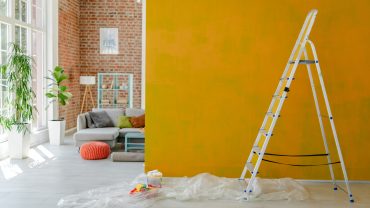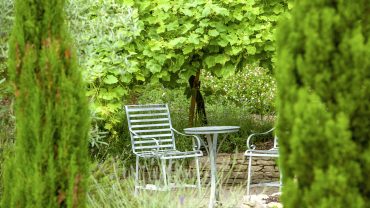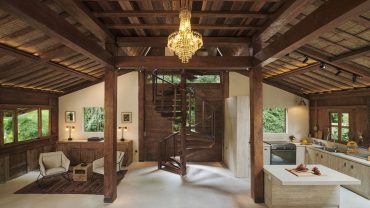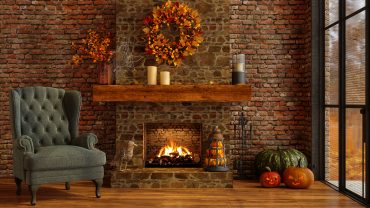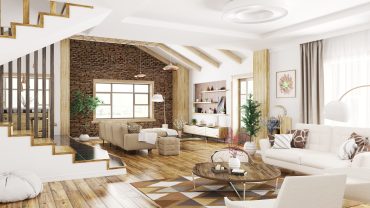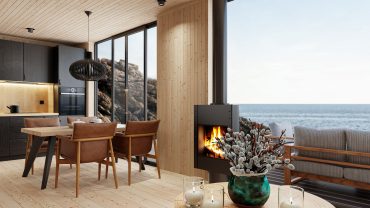Art Nouveau emerged as a distinctive artistic movement in the late 19th and early 20th centuries. Literally meaning “New Art,” it marked a significant departure from the ornate styles of the Victorian era, with its fresh approach to design reflecting the changing social and cultural landscapes of the time. This movement prioritised natural motifs and an aesthetic of fluid beauty.
Over time, artists and designers have incorporated the style into everything from jewellery and glassware to architecture and, of course, to the insides of homes and buildings. So, how has this been achieved? And what are its hallmarks? In other words, what is Art Nouveau interior design?
A History of Art Nouveau

An elegant and spacious bedroom designed with a Nouveau theme. (Credit: Download it via Getty Images)
The Art Nouveau design style follows the principles of a movement that can be traced back to Belgium in the 1880s. Initiated by artists who desired to break away from the historical influences dominating the art scene, proponents of this “new art” championed reform through creativity, seeking freedom from tradition and the restrictions of artforms of the past.
Out of these ideas developed the core tenets of Art Nouveau. Central to this was the use of unruly, flowing lines inspired by the natural world to symbolise the release from constraint. These lines were not just a stylistic choice, but also a philosophical statement against the rigid structures of previous art forms. In fact, all sorts of barriers were broken down: Materials and methods were mixed with abandon; the lines between fine and applied art were blurred, fusing function with beauty; and the innovation of an increasingly industrialised world was melded with traditional crafts. It was, in effect, “new art.”
While Art Nouveau would sweep through Western Europe and the US, it was short-lived, ending as the First World War began. Nevertheless, Art Nouveau works have influenced everything from city skylines to the modernist movement in the latter half of the 20th century.
Key Features of the Art Nouveau Interior Design Style

Art Nouveau style floral design. (Credit: Eblis via Getty Images)
Incorporating Art Nouveau interior design means drawing on the key principles of the movement.
Organic shapes and flowing lines
Sinuous lines are a core tenet of Art Nouveau house interiors, bringing a sense of movement and natural growth to any space. This might be through the use of intricately curved ironwork such as the vine-like railings designed by Victor Horta in Hotel Tassel. Or it could be done through curvy, ornamental furniture.
A signature element of the Art Nouveau design style is the ‘whiplash’ curve. Named for its resemblance to the shape of a whip in motion, it evokes a sense of movement. This feature is often seen in furniture, ironwork, and other decorative items.
Flora and Fauna
Nature is a dominant theme in Art Nouveau house interiors, with motifs of flowers, leaves, vines, and insects like dragonflies or butterflies. This can be incorporated in wallpapers, textiles, and other decorative elements to achieve the look. Artist Gustav Klimt did so in Palais Stoclet with his fantastical swirly mural of the Tree of Life.
Glass, Glass, and more Glass
Art Nouveau is about experimenting with materials, and glass is one of its preferred mediums. Clear glass can be used to bring the outside in, specifically in the form of natural light. Meanwhile, stained glass, both in windows and lampshades, epitomises Art Nouveau interior design, often depicting natural scenes or abstract patterns.
In an Art Nouveau house interior, there is a harmonious blend of these key features. Materials and colours are chosen to create an organic, cohesive environment that reflects the natural world’s beauty and complexity.
Incorporating Art Nouveau Design Style in Modern Spaces

Central London apartment furnished with an Art Nouveau sofa. (Credit: Andreas von Einsiedel via Getty Images)
The legacy of the Art Nouveau design style endures in modern interiors, with its principles of organic beauty and functional art influencing contemporary designers and homeowners alike. To infuse a modern space with the elegance of Art Nouveau, one can start with furniture and decor that echo the style’s flowing lines and natural motifs, adding elements like stained glass or nature-themed wallpapers for an authentic touch.
The Enduring Appeal of Art Nouveau Decor

Luxury kitchen design in a classic art nouveau style. (Credit: Peter_visual via Getty Images)
In conclusion, the enduring charm of Art Nouveau interior design lies in its seamless blend of natural motifs, flowing lines, and innovative use of materials. This style transcends time, offering a unique aesthetic that is both nostalgic and forward-looking. It caters to the modern desire for spaces that are not only functional but also imbued with artistic expression and organic harmony.




